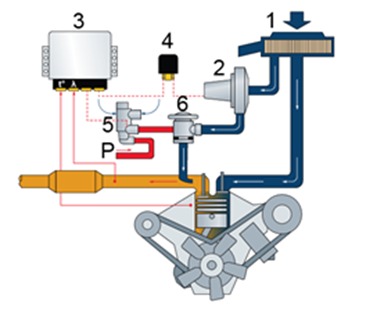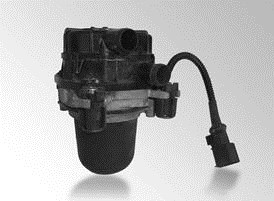The Secondary Air System | HELLA
General Information
This system further lowers the HC (hydrocarbon) and CO (carbon monoxide) values during the cold start phase (catalytic converter not yet active).
A conversion rate of over 90 percent is achieved using a 3-way catalytic converter in stoichiometrically operated gasoline engines. On average, up to 80 percent of the emissions of a driving cycle are emitted during a cold start.
However, because the catalytic converter only works effectively from temperatures of approx. 300°C – 350°C, the emissions must be lowered during the cold start phase using different measures. This is the task of the secondary air system.

- Air filter
- Secondary air pump
- Engine control unit
- Control relay
- Change-over valve
- Combination valve
Function
The active secondary air system usually consists of an electric pump (see figure), the control relay, a pneumatic control valve, and a combination valve.
The system is controlled by the engine control unit. While the system is working, the electric pump is switched on by the engine control unit via the control relay. The pneumatic control valve is actuated at the same time. The valve opens and the vacuum from the intake pipe operates the combination valve. The vacuum causes the combination valve to open and the additional air conveyed by the pump is pumped into the exhaust pipe behind the exhaust valves. As soon as the lambda control is active, the secondary air system is deactivated. The engine control unit deactivates the electric pump and the pneumatic control valve. The combination valve is also closed, preventing hot exhaust emissions from reaching the electric pump and damaging it.
Error indications
Increased emission values during the cold start and warm-up phases can be caused by a lack of post-combustion. The engine warning light may light up for systems which are monitored by the engine control unit's self-diagnosis function.
Causes of failure
- Faulty pump
- Faulty control and combination valve
- Damage due to ingress of moisture
- Faulty ground and voltage supply
- Blocked or leaky cables
Troubleshooting
As for all other troubleshooting and diagnostic work, begin with visual checks, and additionally an acoustic check. For the acoustic check, the electric pump is audible when the engine is cold and at idle.
The sound of the pump stopping can also clearly be heard after the engine has been turned off.
For the visual check, all components should be checked for damage. The cables and hose fittings should be checked particularly closely.
These parts should be correctly attached to the components and not show any signs of chafing. They must also not be kinked or blocked due to excessively tight radii.
The fuses must also be checked for damage. If no fault can be determined, a diagnostic unit can be used for further diagnostics.

Important safety note
Not helpful at all
Very helpful